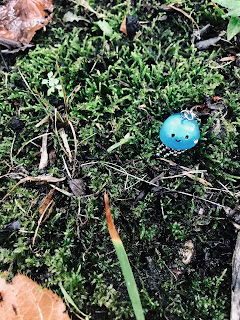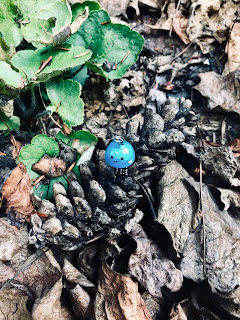Post #2
EVELYN'S BIOLOGY IN LIFE.... continued
Due to technical difficulties, I was forced to continue on a new post, so here I am!
8. Rhizome
It's ginger! And this flavorful food happens to be a rhizome-- a plant with a fleshy root, like their cousins potatoes. Rhizomes are defined as a node that sends out roots and shoots, shoots exactly like da lovely ginga :) does. The chopped off sections of the ginger root used to have plants and shoots attached, which makes the actual ginger a fleshy root-- or a rhizome.
9. Tropism
This artsy picture (which Joey enjoyed posing in immensely), is an example of tropism, or an organism's response to light, gravity, heat, water, ect. Plants roots in general, like this lovely little stalk, respond to gravity-- because the roots grow downward, just like the pull of gravity.
10. Autotroph
Hey, Joey! In the background of this picture is a cherry blossom tree, which is an autotroph. Auto, or self, and troph, or energy. Self-energy, or in easier words, trees make their own food. They use the sun's rays, water, and carbon dioxide to create a sugar called glucose, or their energy.
11. Phloem
Phloem is defined as the tubes, or structures, by which plants transport glucose throughout the plant. In this specific plant, the phloem would be located all throughout the stem and stalk, down to even the roots, located usually outside the xylem, another system of tubes inside the plant. All plants have phloem, or energy would not get to the entire plant, and it would die. This plant is perfectly alive, still green and young, so it must have phloem. Therefore this plant is an example of phloem.
12. Spore
Say, hi, Joey!
This picture contains moss, some mulch, and a cute little jellyfish. (But let's focus on the moss.)
Moss don't produce like you or I-- they use something called spores. Tiny little seed capsules, they are dispersed, and settle down and become buried in soil and grow a new piece, which will grow into a patch, of moss. Spores are the plant version of eggs, or babies-- children of the plant, which will grow into a version of that same plant. So this picture is a example of moss, because moss, unlike you or I, have spores.
Alright. This one was hard to demonstrate, but Joey and I did our best.
The cuticle layer of a plant is the waxy outer layer of a plant's leaves. It protects the leaves' cell wall and epidermis, and reduces water loss. The waxy layer is also water repellent. That is why the water droplets haven't dissolved into the leaf; because of the cuticle layer preventing it.
Still smiling, Joey outlines the xylem in the stalk of this hosta plant, which grew in my own front yard. Xylem transport water from the roots to the stem of the plant through tubes, or by passing through certain cells to the stem. The red dots
15. Endotherm
Endotherm is just a fancy way to say warm-blooded-- an animal who's body regulates it's own internal temperature. And the black and white cat in the middle-right of the picture is just that-- warm blooded. While hanging around my house, socializing; it's body is regulating it's own temperature.
16. Pollinator
Say hello to Bob the bee, (who really didn't want to have his picture taken.) This photo was taken on my family's trip to Longwood Gardens, so credits to the lovely attraction. Anyway, Bob just so happens to be doing what he should-- drinking the sweet nectar that is his energy from the flower. But what is also happening behind the scenes is much more important. Pollen that is created by each flower clings to Bob as he flies from flower to flower-- dropping off and picking up more pollen from each flower as he goes, also known as pollinating. That makes Bob, whether he knows it or not, a pollinator. Bye, Bob! And thanks!
17. Gymnosperm Cone
Say hello to Bob the bee, (who really didn't want to have his picture taken.) This photo was taken on my family's trip to Longwood Gardens, so credits to the lovely attraction. Anyway, Bob just so happens to be doing what he should-- drinking the sweet nectar that is his energy from the flower. But what is also happening behind the scenes is much more important. Pollen that is created by each flower clings to Bob as he flies from flower to flower-- dropping off and picking up more pollen from each flower as he goes, also known as pollinating. That makes Bob, whether he knows it or not, a pollinator. Bye, Bob! And thanks!
This picture also gets credit from Longwood Gardens, as does a few other photos to come. The pinecone Joey is posing on just so happens to be not only just a cone, but also a gymnosperm cone. Essentially, the cone is a pine's seed-- a way to fertilize and create new pine trees. The actual seeds are attached to the upper surface of each scale. This pinecone though, has already dropped it's seeds, hence the brown coloration and open scales. But that means that more pine trees are hopefully on the way-- all thanks to the gymnosperm cone!
18. Pollen
As I talked about in number 16, pollen is the substance that when connected with another flower's stigma, can produce a cross-pollination of the two flowers-- or fertilization. Anyway, as you can see, the yellow powder in the center of the flower is pollen from that flower, waiting to be picked up and carried away by pollinators. So this flower, among many others at Longwood Gardens, has pollen.
19. Ectotherm
This fish (named Fred) was caught by my father (and eaten by my family) this summer, fresh from the pond. Fish, unlike endotherms, are examples of ectotherms, or cold-blooded animals. That means they rely on their environment to regulate their body temperature. Or for Fred, he most likely relied on the temperature of the water to regulate his internal thermometer. Thank you, Fred, for being photo evidence of an ectotherm (and for being our meal.)
20. Seed dispersal
Joey enjoyed getting tickled by this plant immensely, and dubbed it "fluffyplant".
Well, little did he know that the fluffyplant he was getting tickled by was actually a seed. A seed that once dispersed from the mother plant, and given the right conditions, can grow to produce seeds exactly like it once was. But how would the seed be dispersed, you might ask?
By wind, of course! The wind snatches the individual fluffs and blows them away, to a new location, to thrive and flower. (Not literally, of course. This plant has no physical flowers.)
Therefore, fluffyplant is actually an example of seed dispersal, waiting to happen!
21. Taxis
Let's play a game called find Joey. (Hint-- check my mom's shoulder!) This was driving along a country highway in PA, to the same place Fred the Fish was caught and eaten. RIP, Fred. But as you can see, their is no phone in the holder thingy on the dashboard-- my mom navigated the 5 hour drive purely by memory! This itself, is a great feat, especially in the tech-y world we live in. But it is also an example of mnemotaxis-- animals following back along their own trails; navigating by memory and sight. Which is exactly what my mom did- traveling back along the "trails" she has taken before by memory and sight. Credits to my mnemotaxis mom!!
22. Trophy
First off-- I'm a vegetarian. Those burgers were not for me. Second off-- this photo with cute little Joey is a great example of a trophy; heterotrophy. Heterotrophy is defined as an organism who relies on other complex organisms for their energy sources. In our case? My family relied on a cow, another complex organism, for this meal. Heterotrophy in the works. Thank you, cow.
23. Population
Say hi to Oreo and Feather, our neighborhood cats. Feather is the pretty tabby who came right up to the window to check me out, and Oreo is the black and white cat in the background. These two lovely fur balls are fed by my family and our neighbors, and have been fixed by our neighbors. They are a great example of the population of friendly, fed cats in our neighborhood-- exactly two. A population is just a number of the same organism in a certain area. In this case, that number is two.
24. Connective tissue
I don't understand how Joey was smiling so big while being inside an ear, but he never seems to stop. Anywho, this ear is not just an ear-- it is also something called connective tissue, which can come in the form of cartilage, blood, bone, and lymph. In this case, the connective tissue is the cartilage of the ear, that helps form the distinct shape to funnel sound into it. The cartilage itself is more firm, yet flexible tissue that connects the ear to the head, the ear parts to themselves, ect. The ear is literally made up of connective tissue mixed with a little flesh and blood.
25. Coevolution
Annnddd....
Last but certainly not least, we have again the relationship between pollinator and flowering plants, also known as coevolution. Coevolution is two different species that adapt and rely on one another in coexistence. The purple flower has adapted to grow the most scented or bright flowers to attract the most pollinators. Pollinators, in turn, have adapted special features to be able to get nectar and pollen out flowers. So, there you have it-- coevolution from the lense of Bob the bee and a purple flower.


















